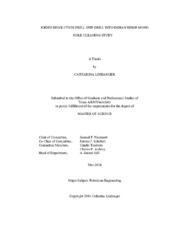| dc.description.abstract | The Integrated Ocean Drilling Program (IODP) uses a variety of technology for use in its deep water scientific research, including the Joint Oceanographic Institutions for Deep Earth Sampling (JOIDES) Resolution (JR) drill ship. The JR drill ship has been selected to core a deep basement hole. The goal is to core approximately 3000 meters below the seafloor in water depths approaching 700 meters. This borehole is estimated to reach and core the igneous lower crust and the crust-mantle transition. Previous expeditions have cored to depths approaching 1500 meters below the seafloor, so this goal is significantly deeper than previous attempts. While it is a capable vessel, the
JOIDES Resolution does have several limitations, mostly related to the drilling fluid system. These limitations need to be understood and their effect on the operation addressed prior to the beginning operations.
The object of this study is to determine if the limitations, such as pumping and storage capabilities, will prevent the ship from being able to core to the desired depth. The first step will be to further define the limitations that are present in the given well plan. This will be done via analysis of drilling hydraulics and hole cleaning capability. From sensitivity analysis using WELLPLAN^(TM), it was determined that the JR drillship will be able to provide hydraulics and hole cleaning capability to reach the upper mantle. Using WELLPLAN^(TM), modeling was done for four different depths along the wellbore to determine the cutting volume concentration buildup, minimum flow rate required, and
equivalent circulating density. By conducting sensitivity analysis on rate of penetration, pump rate, cutting diameter size, and cutting density, it was determined that the drill ship has the capacity to properly clean the hole. After the hydraulics and hole cleaning have been evaluated, the next step is to come up with a viable mud program that can be used for the operation.
The end result is an analysis that not only determines if the geological coring of the crust and mantle transition can be accomplished but gives operational recommendations on how to achieve the stated goal with a minimal risk of drilling problems. With seawater being the main drilling fluid, it is recommended to add gel sweeps at regular intervals to ensure proper transportation of drill cuttings to the seafloor. It is also important to maintain sufficient pump rate, especially with larger sized cuttings or increased rate of penetrations. Using proper flow rate, rate of penetration, and gel sweep intervals will provide sufficient hole cleaning capacity for the JR drillship to core to the Moho. | en |


